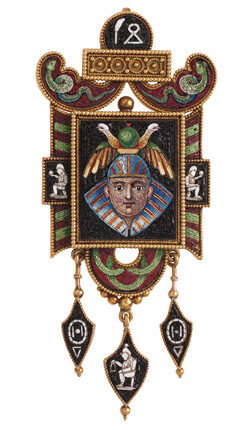Working small in mosaics
Antique Micromosaic brooch (Lang Antique & Estate Jewelry)
A circa 1880/1890 micromosaic brooch from Joden World Resources
Working small in mosaics is a tradition that has existed since the 1500’s. Micromosaics are a special form of mosaic that uses unusually small mosaic pieces (tesserae) to make small figurative images and jewelry pieces. Originally, the technique was used to create mosaic replicas of the altarpieces in St. Peter’s Basilica which were being damaged by the humid conditions. Micromosaics went on to become tourist items because they were small and easily portable so were popular purchases by visitors during the “Grand Tour” period (17th-19th century). They were often inset into furniture, snuffboxes or used for jewelry.
The tesserae in micromosaics were (and are still today) very small. They can be as little as 1 mm (like the lead in a mechanical pencil). One square inch of micromosaic jewelry can have as many as 1,400 tesserae. The “best” works can have 3,000 – 5,000 tesserae per square inch! Traditionally, micromosaics were made using filati. A common method involved melting glass, pulling it into thin rods or threads and then, once it cooled, cutting it into tiny pieces that were then arranged to create a scene or portrait.
Micromosaic earrings by Rachel Sager
The tradition of making micromosaics lives on today. It is possible to purchase filati, but many artists make their own. A quick search on the web will lead you to many examples, new and old. One modern day mosaic artist, Rachel Sager, has many beautiful micromosaic pieces on her website. Below is one example. Be sure to check out her website to see more https://sagermosaics.com/
But working small in mosaics can be something other than micromosaics too. It can be a challenge (those of you who read my last blog post will remember I’m big on challenges!) not only because the tesserae usually have to be cut very small, but also because the size of your substrate impacts the design and composition of your mosaic piece. I enjoy working small sometimes . It certainly helps me learn to cut tesserae more precisely and sometimes it’s just fun to see what you can achieve on a small “canvas”.
I belong to the BC Mosaic Artists group and we exchange what we refer to as “Artist Trading Cards” (ATCs) twice a year. The maximum size allowed for the ATC is 4 X 4”. The flower mosaic is an example of an ATC I made. The heart with dogs is one I made as a gift for friends. Both are 3” X 4”.
Smalti, millefiori, 3” x 4” (Debra Hagen 2020)
Smalti, gold smalti, millefiori and handmade dogs using apoxy sculpt, 3” x 4” (Debra Hagen 2020)
I also make mosaic pendants as you have probably seen on my website. Depending on the tesserae used, it can definitely be an exercise in precision cutting.
And I recently completed a small mosaic portrait using vintage dishes (other than for the eyes which are smalti). It is 2” x 3”. A fun exercise even if the eyes did not turn out as well as I would have liked!
Pendant made with millefiori and smalti (Debra Hagen 2020)
Vintage dishes, smalti, 2’ x 3” inside the frame (Debra Hagen 2020)
Working small has several potential benefits. It can help to hone one’s focus and it definitely provides an opportunity to practice precision cutting. It encourages attention to detail and can be a way to play with design ideas before committing to a large substrate. However, working small can also be a fun way to play - a quick, creative outlet when you only have a short time and just want to make something!
“The human tendency to regard little things as
important has produced very many great things.
Georg C. Lichtenberg”






